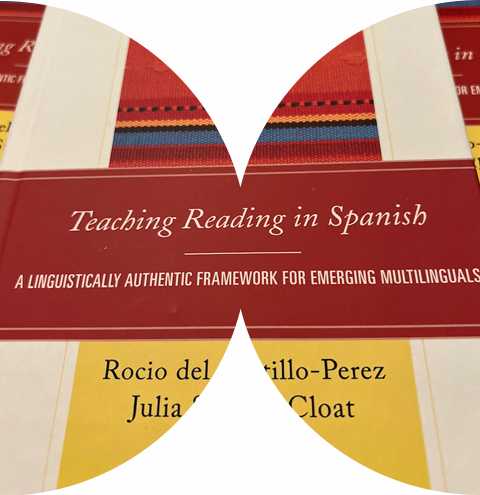What Our Clients Say
Educators of students learning to read in Spanish will find this book to be a powerful source of inspiration that will allow them to build their students’ proficiency and serve as a scaffold to reading in both English and Spanish.
In their book, del Castillo and Cloat provide an instructional framework, based on sound linguistic practices, that can be used to design learning experiences for students. They provide a continuum of reading development, in Spanish, that allows teachers to identify instructional needs and take action to move students forward in their reading development. The authors note the ways in which educators can scaffold the learning experiences based on an individual students’ current level of performance.
Dr. Doug Fisher
Teachers would be well-advised to learn the progressions outlined in the book and design amazing learning experiences that develop each skill so that students can access complex texts. Of course, there is more to teaching reading than leveling texts and students deserve direct and systematic instruction in each aspect of reading, writing, speaking, and listening. But the scaffolds that are outlined in this book, when done well, can ensure that students’ literacy learning is ensured.
Dr. Doug Fisher
Thankfully, the field of education is seeing a growing number of bilingual and dual-language programs. As we come to realize the critical need to grow the Spanish literacy of our multilingual learners, we must also equip our teachers with research-based, practical tools to do so. To meet this need, Rocio Del Castillo & Julia Stearns Cloat have developed a user-friendly guide for teaching reading when the target language is Spanish. Their book, Teaching Reading in Spanish: A Linguistically Authentic Framework for Emerging Multilinguals, is not only a practical guide, but it also offers readers much-needed reminders of equity, asset-based pedagogies, and culturally relevant practices throughout this resource.
Dr. Carol SalvaEducational Consultant /
Seidlitz Education
An untapped source of support that is often overlooked in biliteracy programs is the assets that students bring with them in their home language. This book makes a strong case for knowing, understanding, and leveraging those assets to support the biliteracy development of students who are native speakers of the partner language and those who are native speakers of English.
Although there are many similarities in the English and Spanish languages, early literacy development in Spanish differs in many significant ways from English. This book highlights the similarities and expounds on the differences to allow teachers to better understand the importance of those differences as they seek to support their students' early literacy development in Spanish.
Kris Nicholls, Ph.D.CEO, Nicholls Educational Consulting
Building on culturally relevant pedagogical tenets, insights, and practices, Teaching Reading in Spanish is one of its kind in truly highlighting multilingualism as an asset. Del Castillo and Cloat provided compelling research along with using their experiences as educators and district leaders, the foundation for not only the WHAT, which is approaching biliteracy to teaching reading, but the the HOW to integrate research into the daily reading block using content leveled texts and integrated biliteracy units. More importantly, the WHY behind their incredible work of love demonstrates how they are committed to providing better educational opportunities for all in a diverse world. This book is a true example of how equity can be achieved through a linguistically authentic framework for our emerging multilingual learners, something that many districts have been working towards for many years. Bravo.
Dr. Anna AlvaradoSuperintendent of Schools /
Freeport School District
Bravo! In this book, authors del Castillo and Cloat offer an approachable and refreshing framework for bilingual and dual language educators' Spanish literacy instruction that emphasizes knowing your students, implementing culturally and linguistically authentic literature, leveling books, and planning for meaningful instruction. In a time when educators are all-too-often deprofessionalize, this book acknowledges and extends the vast knowledge and professionalism required of bilingual and dual language educators by rooting its framework squarely in the legacy of civil right movement (when bilingual education gained momentum nationwide) with their key anchors of equity, additive bilingualism, asset based pedagogies, and culturally and linguistically relevant instructional practices. As someone who has been working in bilingual and dual language settings for over 25 years as a bilingual classroom teacher, literacy specialist, and university professor, I can't wait for this book to be in the hands of bilingual and dual language educators. Their emerging multilingual students will benefit as a result!
Kim Kennedy, Ph.D.Founder & CEO, Pocket Profe by Kim Kennedy, Ph.D.
Teaching Reading in Spanish is a balance between theory, research and application. With the rise in multilingual students in our districts, it’s more important than ever to be responsive to their needs and teach literacy that is authentic to the language. The authors of this book weave this knowledge throughout creating a beautiful tapestry of how Spanish literacy works. They have also created a leveling system for leveling books in Spanish, the DCC Leveling Instrument, a tool that is not yet out there in the field. This book is a must for districts who offer native language instruction in Spanish, as the information presented in this book will shift the thinking about linguistically and culturally appropriate instruction in Spanish.
Amy MosqueraAdelante Educational Specialists Group
The success of dual language programs depends on the ability of classroom teachers to grow strong biliterate minds. This book answers so many questions that have been unanswered for years regarding Spanish bilingual reading instruction. It presents a holistic, comprehensive, and culturally appropriate biliteracy model for our U.S. classrooms. It also balances the theories of English instructional practices while considering Spanish linguistic nuances. It truly weaves a tapestry of our dual language students and I am so grateful that they have put forth this text to move our dual language programs forward!
Heather Robertson-DevineBooks del Sur (Illinois)
As I was reading this book, my heart cried with joy, “Finally! Someone has put all of that theory into practice!” As a veteran bilingual coordinator in the state of Illinois, I have been through numerous trainings telling us what we “should do” with our bilingual and multilingual learners in dual language programming. The “how to” manual, however, was missing. Finally, Dr. Del Castillo and Dr. Stearns Cloat have taken all of the theory of teaching reading and put it into an applicable format. I see “Teaching Reading in Spanish: A Linguistically Authentic Framework for Emerging Multilinguals” becoming required reading in all bilingual methods classes.
AJ CrookBilingual Programs Coordinator at DeKalb CUSD 428
In my 20 years working with MLs, I have never read such a comprehensive book about the art of teaching reading in Spanish. This book is very easy to read and gives the reader all the tools necessary to improve literacy instruction for bilingual students. I love that the authors included key anchors that focused on asset based pedagogies as well as seeing multilingualism from an additive perspective. I can't wait to use this as a book study with my staff!
Dr. Maureen CassidyExecutive Director of English Learning
Teaching Reading in Spanish: A Linguistically Authentic Framework for Emerging Multilinguals is a much needed and valuable resource for teachers of multilingual students in bilingual and dual language classrooms. With easy-to-use resources, teachers can put DCC Lectura into action tomorrow!
Tracy MazurkiewiczMultilingual Reading Specialist, Kaneland CUSD 302


Let’s talk about how we can provide practical services and solutions to your organization.

Q2: How do you introduce high frequency words to your students? #TRISchat pic.twitter.com/PXbls7g7j6
— Via Educational Consulting (@ViaEdConsulting) January 24, 2024
©2024 Via Educational Consulting. All rights reserved
©2024 Via Educational Consulting All rights reserved
